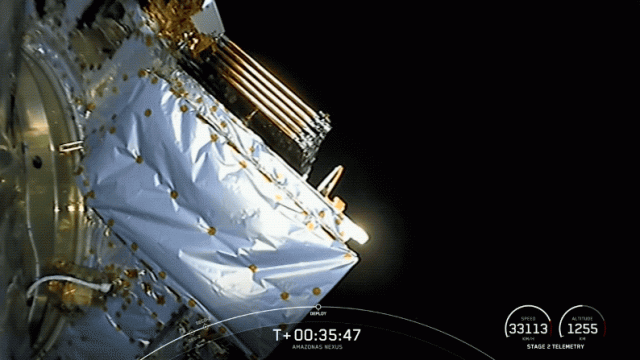A Falcon 9 lit up the Florida skies Monday night in what is now a very familiar scene. The rocket successfully deployed Hispasat’s Amazonas Nexus communications satellite into a trajectory that will take it to a geostationary orbit, from where it will expand the Spanish company’s coverage across the Americas, the Atlantic Ocean, and Greenland.
The rocket took flight at 8:32 p.m. ET from Space Launch Complex 40 at Cape Canaveral Space Force Station in Florida. Some eight minutes later, the main stage booster, B1073-6, performed a successful vertical landing atop the Just Read the Instructions droneship stationed in the Atlantic Ocean. This was the booster’s sixth flight, having previously delivered the SES-22 satellite, ispace’s HAKUTO-R lunar lander, and three batches of the company’s Starlink satellites.
Falcon 9 launches the @Hispasat Amazonas Nexus mission to orbit pic.twitter.com/PvD76cxaOU
— SpaceX (@SpaceX) February 7, 2023
Once in its operational geostationary orbit, Amazonas Nexus will provide coverage for both North and South America, the North Atlantic corridor, and, very excitingly, Greenland. The 5-ton (4.5-metric-ton) high-throughput satellite, built by Thales Alenia Space, will expand Hispasat’s coverage and “will be focused on connectivity services in remote areas and in aerial and maritime mobility settings,” the company says.
Hispasat is a Spanish satellite communications operator that distributes more than 1,250 television and radio channels to its 30 million subscribers through its satellite fleet, which currently boasts nine operational satellites (not including Amazonas Nexus). Monday’s launch was the first time that a Falcon 9 delivered an Amazonas satellite to space, with the previous flights performed by Ariane 5 and Proton-M rockets. That said, a Falcon 9 did deliver the Hispasat 1F satellite in 2018.
The new Amazonas Nexus satellite will serve as the fourth Amazonas satellite currently working in space, and it features an innovative architecture that combines Ku and Ka bands, which multiplies “the total on-board capacity available for commercial use,” according to the Hispasat. The new satellite is expected to operate for the next 15 years.
As for SpaceX, the company just keeps trucking. Monday’s launch was its ninth orbital launch of 2023, which includes eight launches of Falcon 9 and one of Falcon Heavy. It’s also the 16th SpaceX launch in the past nine weeks.
The current 2023 launch cadence sets SpaceX on a pace for roughly 89 orbital launches, but the pace over the past nine weeks pushes that closer to 92. Should the cadence increase — a distinct possibility — that could result in over 100 orbital launches for the calendar year, a stated goal of CEO Elon Musk.
More: Richard Branson’s Satellite Launch Company Isn’t Doing So Hot
